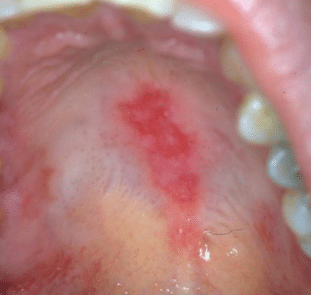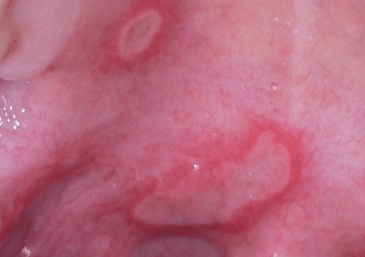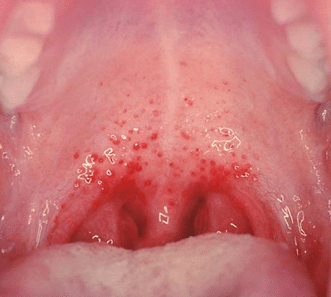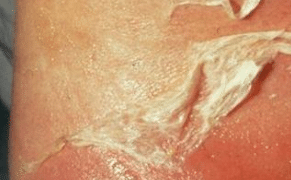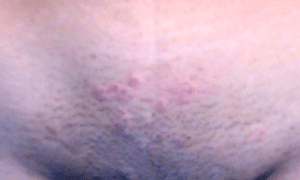Having a mouth burn and blister after drinking or eating a very hot food? Learn more about burns on roof of mouth, second degree burns, skin pealing and pictures of the burnt palate. Also, discover how long to heal burnt roof of mouth blister and the treatment.
Burn on Roof of Mouth Causes
According to the natural structure of the oral cavity, your mouth cavity is covered by a thin delicate mucous membrane. This makes your mouth cavity to be more susceptible to develop burns and blisters if you eat or drink hot food.
The roof of the mouth or hard palate is a potential area of the oral cavity that might develop mouth burns and blisters. Despite the roof of your mouth has a hard special connective tissue, it is the most vulnerable part that can be affected by either thermal or chemical burn.
Your hard palate in the mouth can develop burnt skin and blister due to several factors or causes. The type of mouth burns and blister that can show up may depend on these causes. The common causes of the burnt roof of the mouth include the following:
- Thermal burns
A thermal burn on the skin is usually caused by high temperature or heat energy that may damage the skin tissue to develop a burnt blister. Thermal burn can lead to skin damage that ranges from mild to serious burns depending on the temperature of the heat energy.
The common practices and habit that can lead to thermal burning of the mouth roof include the eating of very hot food and drinking of hot fluids. Also, placing any other burning hot object into your oral cavity can burn your hard palate.
A bite into a very hot food is a common habit that can cause burns and blisters on the roof of the mouth. It is quite normal for you to bite a hot food and burn your mouth without even noticing during the moment. However, you might feel pain on your mouth roof after few minutes of eating the food.
The food that may burn your mouth is always delicious while it is hot and you might not have enough patience to wait until it cools before eating. For instance, pizza is an Italian origin baked dish that can make you salivate and bite it while hot to cause a burn on roof of mouth.
The habit of sipping very hot drinks such as coffee and tea into your mouth is another risk factor that can cause burns and blister in the mouth. Drinking hot fluids can burn the tongue and the smooth surface of the mouth roof.
- Chemical burns
Other than thermal burns, you can also get chemical burns on your mouth roof. The common chemical that can result in mouth burns if they are placed in the oral cavity includes corrosive strong acids, base, detergents, and bleaching agents and disinfects liquids.
If you drink or eat corrosive chemicals, you can develop serious mouth burns in the entire of the oral cavity. Chemical burns can lead to blistering and skin pealing in the oral cavity that can advance into more serious health condition.
Most of the corrosive chemicals are poisonous and not suitable for human consumption. Some of the corrosive chemicals can lead to health complicated problems and even death if no treatment is given to you.
- Electrical burns
If you use your tongue to test the amount of current in dry cells batteries and other electrical appliance, this can cause mouth burns. The flow of the current from the batteries or electrical device can burn various parts of your mouth including tongue, gums, and roof of the mouth.
- Allergic reaction
Burns blisters and skin peeling can occur on the roof of your mouth as a consequence of an allergic reaction. Eating too spicy and salty food can lead to burning of the delicate skin of the hard palate, tongue, gums and other parts of the oral cavity.
Also, eating raw tubers, poison ivy or any other harsh irritant that can stimulate an allergic reaction in your mouth cavity might lead to burnt gums, tongue, and hard palate. It is advisable to avoid eating foods or substances that can irritate your oral cavity to develop burns.
- Oral infections
A burn on roof of mouth can show up as a result of an oral infection. There are several oral infections that can lead to mouth blisters that look similar to skin burns. This blister can appear on gums, plate, tongue or any other parts of the oral cavity.
Some of the infections that can lead to burns like blisters in the mouth include:
- Canker sores
- Cold sores
- Oral thrush
- STDs such as syphilis, HIV, HSV, oral herpes
- Oral cancer
- Scarlet fever
Can you burn the roof of mouth?
Can the roof of the mouth get burnt? Yes, it is possible to develop burns on the roof of your mouth. The hard palate is lined with thin delicate skin that can easily be damaged by high temperature and harsh corrosive chemicals.
Biting a hot food is the common habit that can burn the roof of your mouth. Eating or chewing hot food might be delicious and enjoyable. However, the high temperature of the hot food can burn the roof of your mouth to develop blisters and skin peeling.
Also, you can burn the roof of your mouth in the process of the drinking cup of hot coffee or tea. A single sip of hot coffee or tea can burn the delicate mucous membrane on the roof of your mouth to develop a burnt blister.
Eating or drinking hot food during a cold weather condition can lead to a burn on roof of mouth without even you noticing. The only way you might realize that your mouth roof developed a burnt after taking a hot food or drink is when you notice that there is skin peeling.
Burnt Roof of Mouth Skin Peeling
A burn on roof of mouth that is associated with skin peeling in the affected area is a symptom of more serious skin damage. Blistering and skin peeling is an indication of either second-degree burns or third-degree burns.
Mild burns on the roof of the mouth might not result in the peeling of the skin. However, mild burns in the mouth can only lead to redness and burning sensation in the affected area. Also, mild mouth burns do not show up as blister and it can heal within two days.
Skin peeling on the roof of the mouth can occur after severe burns in the oral cavity. Serious mouth burns can lead to the development of blisters and thickening of the skin with a white appearance. The leathery skin finally becomes soft and loss hence peeling can occur.
You might feel a lot of pain and discomfort in your oral cavity after skin peeling. The affected oral tissue can become more sensitive to salt, spicy and even warm foods. Seriously burnt mouth roof can causes difficulties in eating and drinking.
If a mouth burn causes a severe pain that might prevent you from eating and drinking foods, this could be a second or third-degree burn that needs medical attention. It is advisable to seek the help of your dentist who may assist you in the treatment.
Second degree Burn in Mouth
There are four major levels of burns on the skin. These levels of burns are categorized based on the extent to which the burn damages the skin. These levels of burns on the skin include the following:
- First-degree burns: its symptoms include redness, slight pain, dryness and slight swellings and not basters that show up. This burn only affects the topmost layer of the skin.
- Second-degree burns: This burn is associated with severe pain, redness, inflammation, and tenderness and blistering.
- Third-degree burns: this is a deep skin burn that is associated with thickening of the skin, white blister, and skin peeling.it might also cause severe pain in the affected area.
- Fourth-degree burns: this level of burns includes all the symptoms of second and third-degree burns. These burns can damage internal tissues, tendons, muscles, and
Focusing on a second-degree burn on roof of mouth, it can affect few layers of the mouth skin to develop fluid-filled blisters. This type of the burn is characterized by the following symptoms that include:
- Severe pain in the mouth
- Redness, tenderness and inflamed skin in the affected area
- Dark discoloration of the skin in area affected
- Whitish thick skin
- Skin peeling
Second-degree burns can show up on the roof of your mouth as consequence of thermal or chemical burns in the mouth cavity. This type of burns might not advance into health complicated problem and it can heal within a period of one week.
Burnt Roof of Mouth Blister
A fluid-filled bumps or blisters can show up on the roof of your mouth as a consequence of a burn. A severe burn on roof of mouth is usually characterized with painful bumps that are filled with clear body fluid or serum.
The burnt blisters on your palate can occur when the top layer of the mucous membrane is separated from the oral tissue by the effect of the burns. This may result in the development a pocket that is filled with plasma or serum to form a burnt blister.
The burnt blister on the skin of the mouth cavity might burst and ooze out the fluid after few days. Occasionally, some burnt blister can heal without bursting or ooze out the fluids. These blisters can take few days to go away.
Second and third-degree burns on the mouth roof can lead to oral blisters that are associated with skin peeling. The peeling of skin in the mouth can advance into mouth sores and ulcers. The problem can worsen if the sores are infected by bacteria and fungi.
In case you develop mouth blister after a burn, it is advisable to keep your entire oral cavity clean by washing it with an appropriate mouthwash that cannot irritate more the burnt blister. Alternatively, you can seek the guidance of your doctor.
Burnt Roof of Mouth How Long to Heal
How long does it take a burn on the roof of your mouth to heal? The time that your burnt roof of mouth can take to heal may depend on the type of the burn. For instance, mild burns can take few days to heal compared to severe burns.
A mild burn on roof of mouth that does not show up blisters can about take 2 to 3 days to heal completely. However, severe burns that lead to blistering and skin peeling can take an approximate period of about one to two weeks to heal.
In few occasions, severe burns on the roof of the mouth can advance into chronic sores and ulcers that won’t heal. This could be an indication of health complicated problem that needs you to go for medical diagnosis and treatment by visiting your dentist.
Burn on Roof of Mouth Treatment
You can treat burns on the roof of your mouth by using various treatment methods basing on the type of the burn. You can go for medical treatment in case you develop severe burns in your oral cavity that causes difficulties in eating.
You can visit your doctor for medical treatment. After visiting your doctor, he/she may decide the suitable diagnosis and treatment plan that can help you to relieve mouth burns. Your doctor might use the following treatment method that includes:
- Prescription of oral medication such as Ibuprofen and acetaminophen that can help to relieve the inflammation and reduce pains.
- Prescription of oral antibiotics such as penicillin, oxacillin, cefazolin, ampicillin, and amoxicillin that can prevent the infection of blister by bacteria and fungi.
- Surgical procedure and skin grafting that can help to treat severe mouth burns.
Home remedies
For the case of having a minor burn on roof of mouth, no need for you to go for medical treatment. You can alternatively use home remedies to treat minor burns in your oral cavity. Try the following natural treatment methods that include the following:
- Cooling
Cooling is an effective home remedy that can help to take way heat on burnt skin and soothe the affected area. Cooling can relieve pain on the burn immediately to facilitate the healing:
How to use:
- Get something frozen or cool such as ice cubes, frozen juice, cold milk, ice creams
- Sip a cold drink into your mouth
- Allow it to stay in your mouth few minutes before swallowing
- Alternatively, place the ice cube into your oral cavity in the affected area
- Repeat this procedure several times until the pain go away
- Honey
Raw honey can help to soothe painful burnt skin in your oral cavity. it also has antiseptic properties that can help to prevent the infection of the burnt blister.
How to use:
- Get one teaspoon of raw honey
- Sip it slowly into your mouth cavity
- Use your tongue to spread it to the affected area
- Allow it to stay in your mouth cavity for 5 minutes before swallowing it
- Repeat this steps three times in a day for few days until the burns heal completely
- Aloe Vera
Aloe Vera has the soothing, antibacterial, antifungal, and anti-inflammatory that can help in the healing of a burn on roof of mouth.
How to use:
- Get the Aloe Vera herbal gel
- Apply it directly to the affected area of your mouth
- Rinse your mouth with water after 10 minutes
- Repeat this treatment three times in a day about one week until the burn go away
- Salt rinse
You can use salt rinse as a home remedy that can help to treat burns on the roof of your mouth. salt has the ability to soothe and relieve inflamed skin to facilitate the healing.
How to use:
- Mix ¼ teaspoon of table salt into one cup of cold water
- Swish your mouth cavity with the solution several times before spitting it out
- Repeat this steps three times in a day until the burns heal completely
- Baking soda
Baking soda has a natural ability to soothe and facilitate the healing of the mouth burns. It also has the astringent properties that can help to relieve burns and blisters on the affected area.
How to use:
- Mix ½ teaspoon of baking soda into cold water
- Swish the solution gently into your mouth cavity
- Spit it out after 5 minutes
- Repeat this procedure three times in a day until the mouth burn go away
- Avoid too hot, spicy, salty and crunchy foods
According to WebMD, they attribute that you can change your meals and eating habit in a few days to facilitate the healing of a burn on roof of mouth and other parts of the oral cavity. You can avoid eating certain types of food that might irritate more the burn.
It is advisable to avoid eating too hot, spicy, salty and crunchy food that can irritate the burns. You can alternatively go for cold and soft foods such as frozen juice, cold milk, and other soft meals. Crunchy foods can aggravate the burns to cause more pains that might delay the healing.
Further References
- Burns on roof of the mouth: https://www.colgate.com/en-us/oral-health/life-stages/adult-oral-care/burned-the-roof-of-your-mouth-heres-how-to-cope-1215
- Causes of mouth burns: https://www.webmd.com/first-aid/types-degrees-burns#1
- Burnt roof of the mouth and skin peeling: https://www.buzzfeed.com/carolinekee/heres-what-to-do-if-you-burn-the-shit-out-of-your-mouth?utm_term=.ptYADyQ5j6#.inEw2Nye1p
- Second degree burns in the mouth: https://app.figure1.com/rd/images/575b299b757843777711fca5
- how to treat mouth burns: https://www.healthline.com/health/how-to-treat-a-roof-of-mouth-burn
- home remedies for mouth burns: https://www.livestrong.com/article/551197-how-to-heal-an-internal-mouth-burn/


